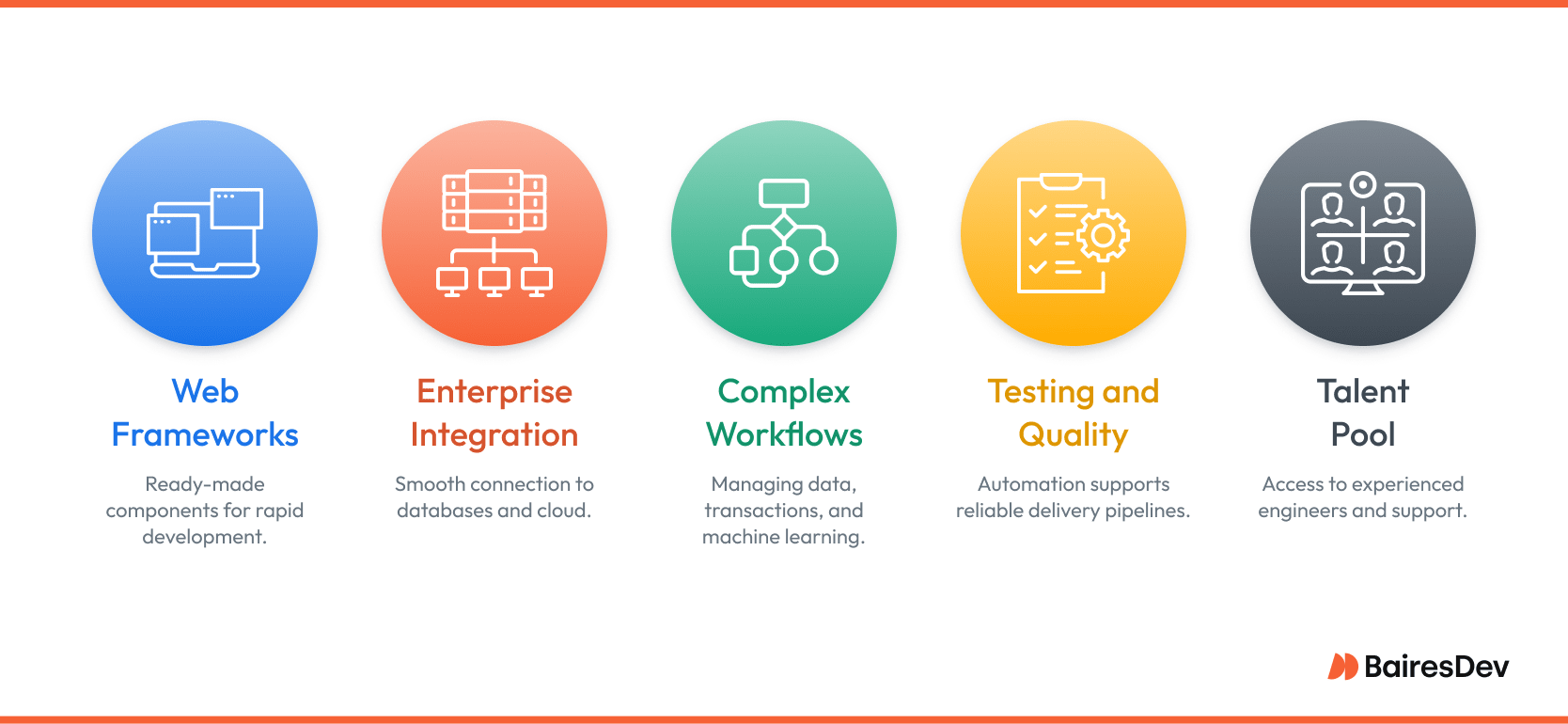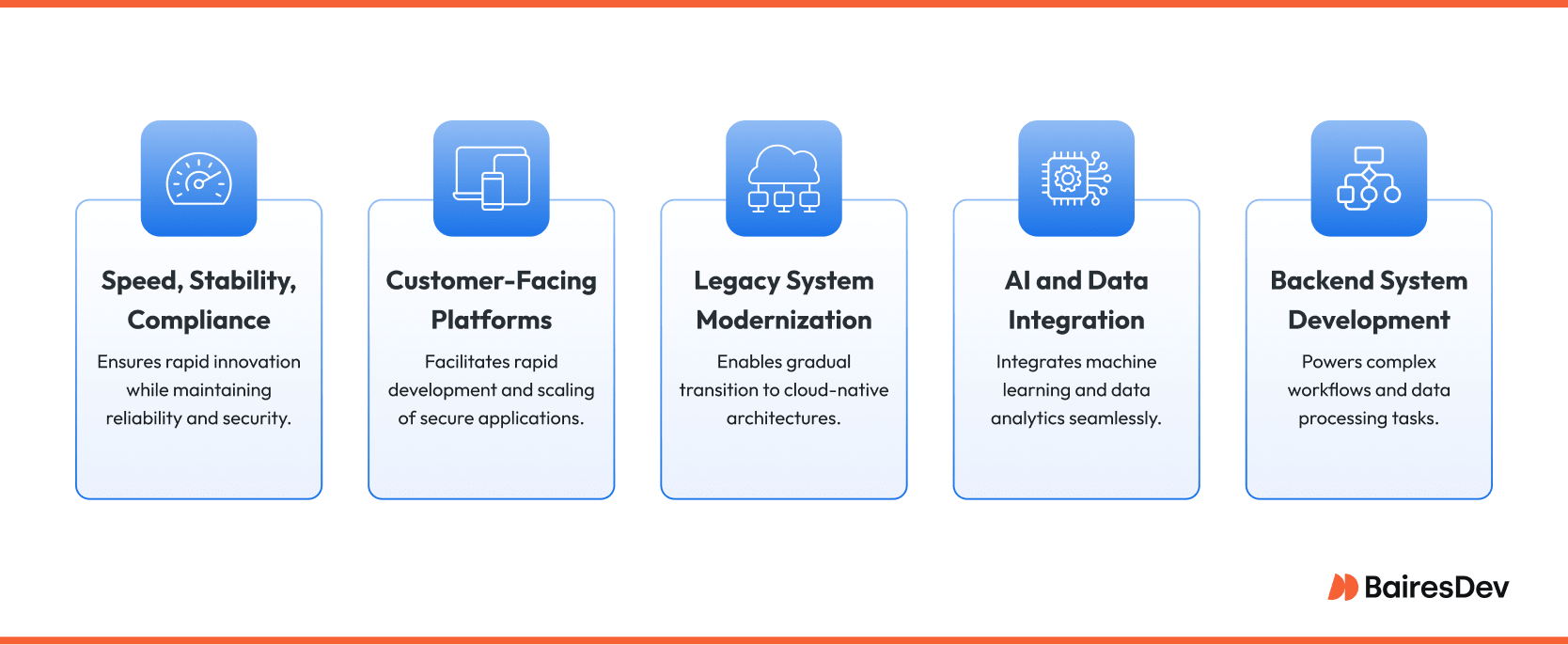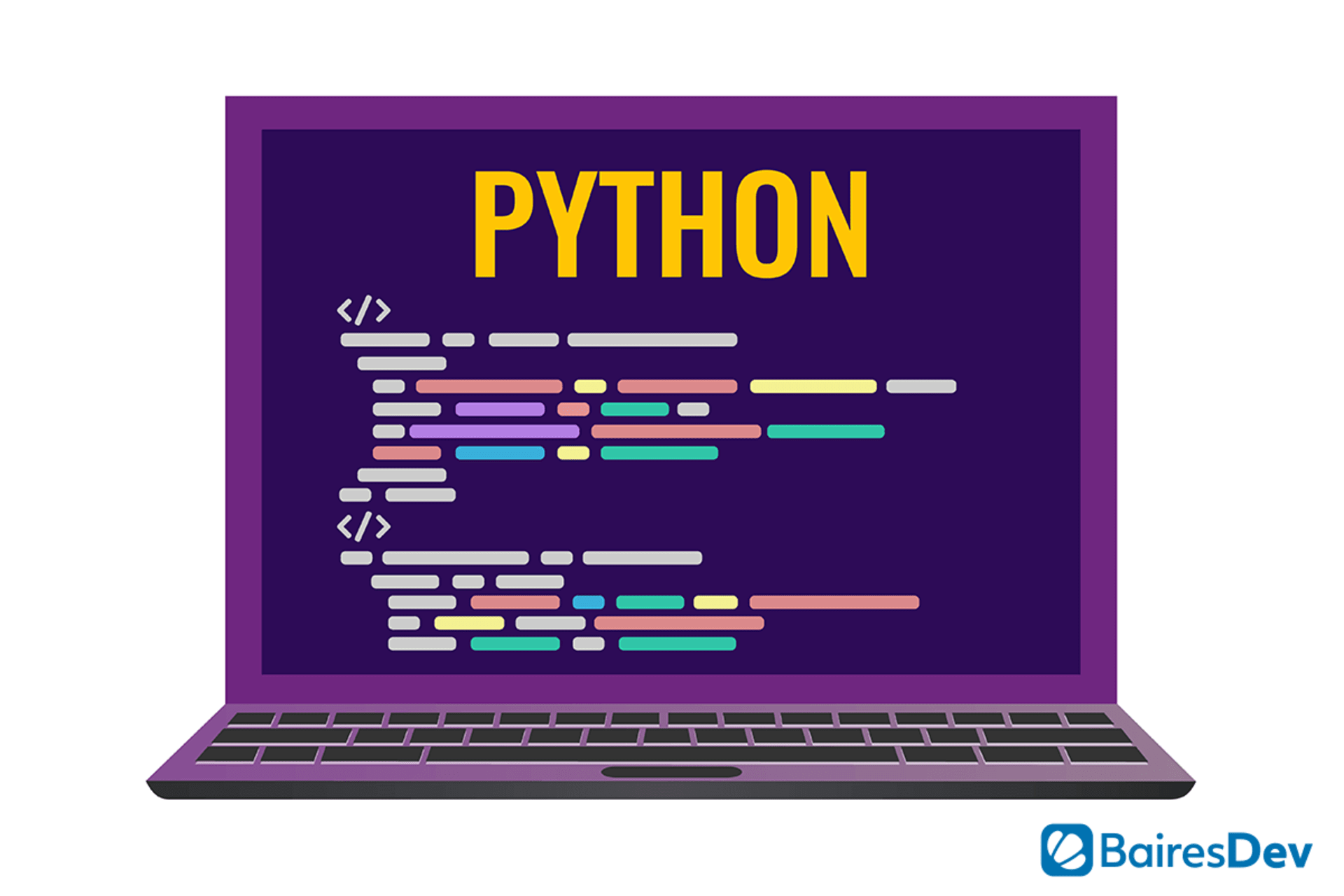Python has been around since the early 90s and has become a staple of web developers across the globe. As an interpreted, high-level, general-purpose language, Python’s design philosophy encourages code readability and uses an object-oriented approach for clear, logical code for projects of all sizes.
Thanks to its extensibility and availability of mature libraries and frameworks, Python is used in nearly every industry for a variety of applications. Python’s ecosystem allows engineering teams to deliver faster, integrate with existing systems, and focus on business-critical features rather than reinventing commodity components. There’s another benefit to Python’s popularity: A strong talent pipeline backed by an active global community.
For larger organizations, this means access to skilled Python developers, mature tools, and proven design patterns that reduce risk and support long-term maintainability. Companies can quickly expand their teams or outsource development. At the same time, individual developers can rely on public resources and the community when the going gets tough.
Is Python still widely used for Web development?
According to the 2024 Stack Overflow survey, Python is used by 51% of professional developers, putting it in third place (behind JavaScript and HTML/CSS). Beyond its application in big data, AI, and machine learning, Python plays a big role in building scalable web platforms, high-performance APIs, and cloud-native services. Its robust ecosystem makes it particularly appealing for enterprise projects.
From a business perspective, Python offers a number of advantages for web development. It’s a good choice for rapid prototyping and enables fast delivery, allowing businesses to quickly respond to shifting trends and customer demands. Python’s leading web frameworks, such as Django and Flask, provide enterprise-grade scalability and security. It’s a also good choice for integration, making it a prime candidate for building complex web applications.
Businesses need to move fast and don’t like to break things in the process. That’s where Python fits in. It allows companies to iterate and introduce new features while relying on mature and proven libraries and frameworks. Python offers fast delivery without niche technologies and hard-to-source skill sets.
Why businesses stick to Python web development
Let’s unpack this to understand why businesses choose Python over other languages, and how it allows them to move fast without cutting corners.

Python web frameworks
Take Django. It gives you an admin panel, user authentication, and a solid ORM right out of the box. You’re not wasting time building the basics from scratch. The Flask web framework, on the other hand, gives you more flexibility when you need something lightweight or highly customized. Either way, Python frameworks help engineers focus on what matters: building the actual product, not reinventing plumbing.
Integration with diverse enterprise systems
Integration is another reason Python holds up so well. Need to connect to a PostgreSQL or MongoDB database? No problem. Hooking into AWS or Azure services? There are well-supported libraries for that. Python is easy to integrate with other languages, such as C, Java, .NET, Objective-C, and Ruby. You can build out REST APIs, handle background jobs with Celery, and spin up cloud-native services — all without fighting the tools.
Complex workflows
Then there’s Python’s strength with data-heavy workflows. Whether you’re building a customer dashboard, processing transactions, or layering in machine learning, Python’s mature ecosystem makes handling complex backends far more manageable. This is especially important when combined with scalable cloud environments and containerized deployments (e.g., Docker, Kubernetes).
Testing and quality
And let’s not ignore testing. With libraries like pytest, unittest, and Django’s own testing tools, it’s easier to integrate automated tests into the CI/CD pipeline. Businesses can’t afford buggy releases or downtime, this isn’t a nice-to-have. It’s critical. What happens of things go wrong? Your team can rely on a lot of online resources and active community to troubleshoot and identify the bes solution for the problem.
Talent pool and community
Python’s popularity means you’re not betting on an obscure or dying technology. There’s a deep talent pool out there, which matters when you need to scale a team or keep a system running long term.
Python Web Development in Leading Enterprises
Many of the world’s most prominent companies rely on Python to power critical parts of their technology stack. Here are a few examples:
- Industrial Light and Magic uses Python to manage its vast production pipeline, keeping complex visual effects projects running smoothly and efficiently.
- Google App Engine is built with Python at its foundation, offering a flexible platform for developers to build and deploy scalable web applications.
- Instagram depends on Python and Django to support its massive social media ecosystem, ensuring fast and reliable service for hundreds of millions of users.
- Spotify applies Python to process and analyze huge volumes of data, improving its music recommendations and personalizing user experiences.
- Netflix integrates Python into its machine learning systems, using it to enhance content recommendations and optimize streaming quality.
- Dropbox originally built its entire software stack in Python, taking advantage of the language’s simplicity and adaptability to deliver seamless file-sharing services.
- Stripe relies on Python to develop secure and high-performance application programming interfaces that handle sensitive financial transactions worldwide.
At companies like Google and Instagram, Python is often used to simplify complex database interactions and strengthen application security through well-structured frameworks.
How Enterprises Use Python Today
Python has become a pillar of modern web development because it pairs expressive code with a mature ecosystem of frameworks and libraries. When a company’s revenue flows through a browser or mobile app, the language’s versatility helps engineering leaders move quickly without compromising stability or compliance.

Building customer-facing platforms
Across SaaS products, fintech applications, and online marketplaces, Python allows teams to ship an initial release in weeks and then scale it to millions of users. Frameworks such as Django and FastAPI come with ready-made components for authentication, role-based access control, and multi-tenant architecture, so developers focus on business logic rather than plumbing. In payments and trading, Python also integrates smoothly with event-stream platforms like Kafka or Pulsar, which keeps real-time balances and risk calculations accurate even under heavy load.
Modernizing legacy systems
Many enterprises still depend on monolithic applications written in Java or .NET. Instead of replacing the entire system at once, architects often wrap the existing code behind an API gateway and carve out new functionality as Python microservices. This “strangler-fig” approach avoids downtime while gradually moving to a cloud-native stack. Because Python communicates cleanly over REST or gRPC, the new services can coexist with the old codebase until the migration is complete.
Developing complex backend systems
Python’s concurrency tools and orchestration frameworks make it a natural choice for workflow engines and data pipelines. Engineers use Celery, Temporal, or Apache Airflow to coordinate long-running tasks such as invoice generation, loan approval, or nightly data reconciliation.
Combined with the language’s data stack (Pandas, SQLAlchemy, Polars), these services feed analytics dashboards embedded directly in customer portals. Built-in OpenTelemetry support also means observability is not an afterthought; traces and metrics flow automatically into Grafana or Datadog for quick troubleshooting.
Enabling AI and data-driven features
Finally, Python remains the default language of machine learning. Enterprises embed recommendation models, fraud detectors, and large-language-model chat helpers into their web applications by exposing lightweight inference endpoints written in FastAPI or TorchServe.
A model trained in Jupyter can move through a CI pipeline and land in production behind a rate-limited API, often with latencies under fifty milliseconds. That tight feedback loop lets product teams experiment with new AI features without retooling their entire stack.
In short, Python helps technology leaders deliver customer value faster, modernize safely, and infuse intelligent capabilities into their platforms—all while meeting the reliability and compliance standards that enterprise software demands.
Architecture and Framework Decisions
Selecting an architectural style and a web framework is the first strategic call you make on a Python project. These choices decide how fast you can ship, how easily you can grow, and how much engineering overhead you carry over the life of the product. Because our clients are technology executives who manage complex portfolios, the goal is always to balance delivery speed with long-term stability and compliance.
Framework selection
Django is the complete toolkit. It brings authentication, an admin interface, an object relational mapper, and a mature security posture in one package. It works best when you need to launch a full featured platform that must satisfy an audit right out of the gate.
Flask is minimal by design. You import only the extensions you need, which keeps the code base lean when the scope is limited to a single service, an exploratory proof of concept, or a small internal tool.
FastAPI falls between those two. It offers type annotations, asynchronous request handling, and automatic documentation, so it excels at high throughput application programming interfaces that power mobile apps or streaming dashboards.
Think of the decision this way. Choose Django when you need batteries included, pick Flask for pure flexibility, and reach for FastAPI when raw performance and clean typing matter most.
Architecture style
A monolith remains the simplest shape for a young product. All the code lives in one repository, deployments are straightforward, and new contributors can see the entire system at a glance.
As the organization and the code base both expand, the monolith may start to slow parallel development. This is when microservices earn their keep. Each domain team owns its own service, its own release rhythm, and its own runtime dependencies. The trade-off is a jump in operational complexity, because you now manage many repositories, pipelines, and monitoring dashboards.
Serverless functions offer a third option for workloads that spike unpredictably or sit idle most of the day. You pay for execution time only, and the cloud provider handles scaling, but cold starts and vendor limits can be a concern. Mature platforms usually land on a hybrid model. A core monolith still handles cross cutting concerns like authentication and billing, microservices cover fast moving business domains, and serverless functions absorb event driven or seasonal traffic.
Scaling in practice
Whichever pattern you adopt, traffic growth will eventually stress the original design. Horizontal scaling comes first.
Add more Gunicorn or Uvicorn workers behind a load balancer, and you gain an immediate lift without touching code. If endpoints spend much of their time waiting on external resources, adopt asynchronous request handling to free up worker threads. Offload heavy or unpredictable work to a task queue such as Celery so that web requests stay responsive. Place a cache like Redis in front of frequent queries, and introduce a content delivery network to shorten the round trip for static assets.
None of this works for long without observability, so write structured logs from day one, push traces into OpenTelemetry, and alert on latency before customers feel it. Finally, run everything in containers that deploy through a repeatable pipeline. That single discipline lets you roll out fixes in minutes rather than hours and keeps weekend emergencies to a minimum.
When you make these decisions with clear business priorities in mind, Python can stay nimble from first commit to public listing. A disciplined partner that understands enterprise constraints will help you keep that trajectory intact.
Testing, Delivery, and Operations at Scale
Modern web platforms succeed or fail on their ability to ship new features quickly without breaking what is already in production. The most effective way to achieve that rhythm is through disciplined engineering workflows that automate the routine and highlight the exceptional.
Continuous integration and delivery pipelines sit at the center of this approach. Every code change is automatically built, tested, and reviewed, so quality checks happen in minutes rather than days. When releases become routine, teams can push updates as business needs evolve instead of waiting for the next “big-bang” launch.
After deployment, reliable service depends on clear visibility into system health. High-level performance dashboards, near-real-time alerts, and a culture of root-cause analysis give leadership an instant view of user experience and infrastructure cost. When development and operations share that information, they can spot trends early, allocate resources wisely, and plan capacity ahead of demand instead of reacting to outages.
Security and compliance weave through every layer of this process. Encryption, audit trails, and role-based access are now table stakes, while regional privacy laws and industry regulations add their own requirements. Treating these controls as first-class citizens, tested and verified alongside application code, means you can prove compliance on demand and still move at the speed of the market. The result is a delivery engine that balances rapid innovation with the reliability and trust that enterprise clients and end users expect.
Conclusion
For technology leaders tasked with delivering reliable web development projects on an aggressive timeline, Python offers a practical route to both speed and stability.
Python libraries and frameworks shorten the gap between a business requirement and a working feature, and the extensive ecosystem allows teams to integrate data science, AI, and cloud services without re-engineering the core application. Because Python code is readable and widely taught, you gain a sustainable talent pipeline and reduce the onboarding curve for new hires—critical advantages when experienced developers are scarce and project backlogs keep growing.
Equally important, Python aligns well with enterprise demands for compliance and operational rigor. First-class security libraries, robust testing tools, and proven deployment patterns help engineering organizations meet SOC 2, HIPAA, or PCI obligations without slowing release cycles. The language’s portability also simplifies hybrid-cloud and multicloud strategies, giving CIOs flexibility as infrastructure needs evolve.
When you combine Python’s strengths with a seasoned near-shore partner, the result is a delivery model that compresses time to market, lowers total cost of ownership, and scales alongside the business. In short, Python is not merely another language to add to your stack; it is a strategic asset that turns engineering velocity into measurable competitive advantage.
If you enjoyed this article, check out more Python content:
- What Can a Good Python Developer Do to Help Your Company?
- How to Hire a Python Programmer
- Is Python Good for Software Development?
- JavaScript vs Python: A Comparison and How to Choose
- 9 Top Python Libraries for Machine Learning
- Python and Machine Learning
Frequently Asked Questions
Why should an enterprise pick Python over JavaScript for new web initiatives?
Python’s mature frameworks shorten development cycles, its syntax keeps codebases readable, and its rich package ecosystem lets teams integrate analytics, AI, and cloud services without heavy re-engineering. Together these traits reduce time to market and lower long-term maintenance costs.
How does Python fit into an existing microservices or hybrid-cloud architecture?
Python services communicate seamlessly over REST or gRPC and containerize cleanly for deployment to AWS, Azure, or GCP. This interoperability lets teams add new functionality in Python while legacy services continue to run in Java, .NET, or Node.
What security and compliance capabilities does Python offer for regulated industries?
The ecosystem includes mature libraries for encryption, authentication, and audit logging, while frameworks like Django ship with built-in protections against common web threats. Combined with automated testing and code scanning, these tools help meet SOC 2, HIPAA, PCI DSS, and GDPR requirements.
How does Python support advanced analytics and machine learning inside a web product?
The same libraries data scientists use (NumPy, Pandas, TensorFlow, PyTorch) integrate directly into web backends. This allows engineering teams to expose real-time recommendations, forecasting, or fraud detection through scalable API endpoints without switching languages.
Is it practical to introduce Python alongside a monolithic legacy platform?
Absolutely. Many enterprises use the strangler-fig pattern to wrap the existing application behind an API gateway, then replace specific domains with Python microservices. This approach modernizes the stack incrementally without the risk of a full rewrite.







